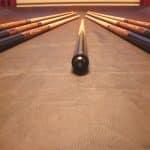Can Pool Balls Make a Difference?
Table of Contents
If you are playing pool for years or if you are just starting out playing pool, you’ll have one question that keeps you bothered i.e., can pool balls make a difference?
In short, the answer is, yes. Pool balls make a difference because of the material, roundness, finish, accuracy, and reliability of the balls. These all factors cumulatively make a difference for any player who is at any stage of their career.
Now, we are going to look at the evolution of pool balls from wooden to ivory and plastic to modern high-tech resins.
A brief history of the pool balls:
The history of pool balls is very interesting. From the 17th to early 20th century, there were different materials used for manufacturing pool balls such as ox-bone, wood, clay, and ivory. The most favorable material was Ivory which was acquired from the tusks of Asian Elephants. To fulfill this increasing demand, Elephants were being slaughtered for the acquisition of the tusks. In the 19th century, Elephants became an endangered specie acquiring tusks harder. Manufacturers’ started to look for another material to make pool balls.
In 1869, John Wesley Hyatt invented a new material known as celluloid which was equivalent to ivory pool balls in terms of the play. These pool balls were made of camphor, nitrocellulose, and alcohol.
All the qualities were similar to ivory pool balls, but they had one significant disadvantage, they exploded while playing. The one component which was used in its composition was nitrocellulose which had highly combustible properties and is also known as gun cotton.
This invention, however, not proved to be a long-term solution for the billiards industry.
Modern High-end Phenolic Resin Pool Balls:
After the invention of explosive pool balls, people started to seek a safer material for the composition of pool balls. In 1923, a company named Saluc invented a stable and high-impact resistant material called phenolic resin. This company still exists by the name Aramith.
The unique composition made these pool balls still a contemporary choice for many players in the industry. Aramith utilizes different methods to make these pool balls more balanced, reliable, accurate, and high-impact resistant. It is believed that a set of phenolic resin pool balls can last up to 40 years. The phenolic resin pool balls are still considered one of the best pool balls up to this date.
Due to their distinctive attributes, these pool balls are expensive, but the top choice of most billiard players.
Polyester Resin Pool Balls:
Another material that is used for the manufacturing of pool balls is polyester resin. These pool balls tend to have lesser reliability as compared to phenolic resin. These pool balls are less durable and can get chips and nicks easily while playing. Due to their non-reliable attributes, they are more than sufficient for beginners who are just learning this game. A player who is a habitual player of phenolic resin pool balls may find himself struggling while playing with these balls as there is a lot of variation in terms of roundness, precision, and diameter tolerance.
Conclusion:
In conclusion, there is a continuous evolution of the pool balls. From blasting pool balls to phenolic and polyester resin pool balls a lot has been changed for the better. A set of pool balls can make a difference, and phenolic pool balls are a way better choice.






